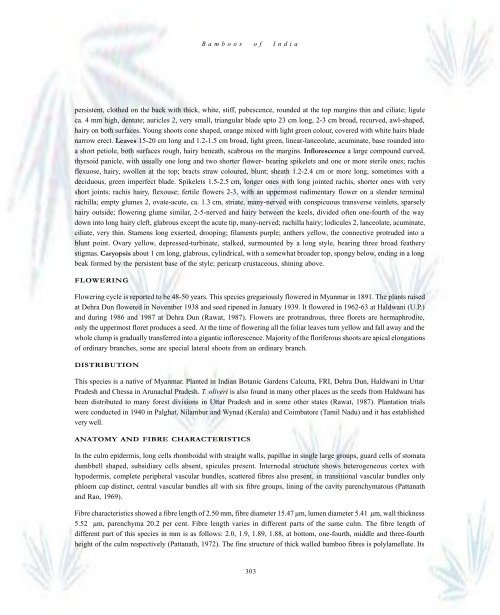Create successful ePaper yourself
Turn your PDF publications into a flip-book with our unique Google optimized e-Paper software.
Bamboos of India<br />
persistent, clothed on the back with thick, white, stiff, pubescence, rounded at the top margins thin and ciliate; ligule<br />
ca. 4 mm high, dentate; auricles 2, very small, triangular blade upto 23 cm long, 2-3 cm broad, recurved, awl-shaped,<br />
hairy on both surfaces. Young shoots cone shaped, orange mixed with light green colour, covered with white hairs blade<br />
narrow erect. Leaves 15-20 cm long and 1.2-1.5 cm broad, light green, linear-lanceolate, acuminate, base rounded into<br />
a short petiole, both surfaces rough, hairy beneath, scabrous on the margins. Inflorescence a large compound curved,<br />
thyrsoid panicle, with usually one long and two shorter flower- bearing spikelets and one or more sterile ones; rachis<br />
flexuose, hairy, swollen at the top; bracts straw coloured, blunt; sheath 1.2-2.4 cm or more long, sometimes with a<br />
deciduous, green imperfect blade. Spikelets 1.5-2.5 cm, longer ones with long jointed rachis, shorter ones with very<br />
short joints; rachis hairy, flexouse; fertile flowers 2-3, with an uppermost rudimentary flower on a slender terminal<br />
rachilla; empty glumes 2, ovate-acute, ca. 1.3 cm, striate, many-nerved with conspicuous transverse veinlets, sparsely<br />
hairy outside; flowering glume similar, 2-5-nerved and hairy between the keels, divided often one-fourth of the way<br />
down into long hairy cleft, glabrous except the acute tip, many-nerved; rachilla hairy; lodicules 2, lanceolate, acuminate,<br />
ciliate, very thin. Stamens long exserted, drooping; filaments purple; anthers yellow, the connective protruded into a<br />
blunt point. Ovary yellow, depressed-turbinate, stalked, surmounted by a long style, bearing three broad feathery<br />
stigmas. Caryopsis about 1 cm long, glabrous, cylindrical, with a somewhat broader top, spongy below, ending in a long<br />
beak formed by the persistent base of the style; pericarp crustaceous, shining above.<br />
FLOWERING<br />
Flowering cycle is reported to be 48-50 years. This species gregariously flowered in Myanmar in 1891. The plants raised<br />
at Dehra Dun flowered in November 1938 and seed ripened in January 1939. It flowered in 1962-63 at Haldwani (U.P.)<br />
and during 1986 and 1987 at Dehra Dun (Rawat, 1987). Flowers are protrandrous, three florets are hermaphrodite,<br />
only the uppermost floret produces a seed. At the time of flowering all the foliar leaves turn yellow and fall away and the<br />
whole clump is gradually transferred into a gigantic inflorescence. Majority of the floriferous shoots are apical elongations<br />
of ordinary branches, some are special lateral shoots from an ordinary branch.<br />
DISTRIBUTION<br />
This species is a native of Myanmar. Planted in Indian Botanic Gardens Calcutta, FRI, Dehra Dun, Haldwani in Uttar<br />
Pradesh and Chessa in Arunachal Pradesh. T. oliveri is also found in many other places as the seeds from Haldwani has<br />
been distributed to many forest divisions in Uttar Pradesh and in some other states (Rawat, 1987). Plantation trials<br />
were conducted in 1940 in Palghat, Nilambur and Wynad (Kerala) and Coimbatore (Tamil Nadu) and it has established<br />
very well.<br />
ANATOMY AND FIBRE CHARACTERISTICS<br />
In the culm epidermis, long cells rhomboidal with straight walls, papillae in single large groups, guard cells of stomata<br />
dumbbell shaped, subsidiary cells absent, spicules present. Internodal structure shows heterogeneous cortex with<br />
hypodermis, complete peripheral vascular bundles, scattered fibres also present, in transitional vascular bundles only<br />
phloem cap distinct, central vascular bundles all with six fibre groups, lining of the cavity parenchymatous (Pattanath<br />
and Rao, 1969).<br />
Fibre characteristics showed a fibre length of 2.50 mm, fibre diameter 15.47 µm, lumen diameter 5.41 µm, wall thickness<br />
5.52 µm, parenchyma 20.2 per cent. Fibre length varies in different parts of the same culm. The fibre length of<br />
different part of this species in mm is as follows: 2.0, 1.9, 1.89, 1.88, at bottom, one-fourth, middle and three-fourth<br />
height of the culm respectively (Pattanath, 1972). The fine structure of thick walled bamboo fibres is polylamellate. Its<br />
303


